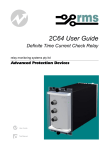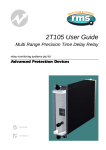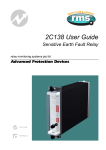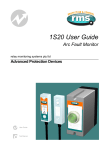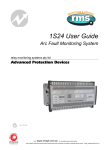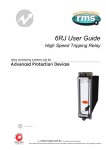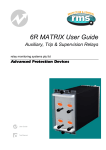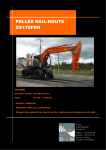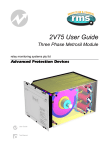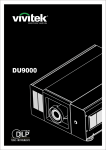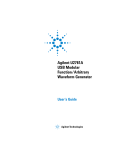Download 2C73 User's Guide
Transcript
4M300 / 4M320 User Guide Test Block System relay monitoring systems pty ltd Advanced Protection Devices User Guide Test Manual 4M320 Test Plug Depicted 4M300 User Guide About This Manual This User Guide covers all 4M300 Test Blocks manufactured from April 2009. Earlier test blocks & plugs do not necessarily incorporate all the features described. Our policy of continuous may means that extra features & functionality may have been added. The 4M300 / 4M320 User Guide is designed as a generic document to describe the common operating parameters for all relays built on this platform. Some relay applications are described but for specific model information the individual “K” number Product / Test manuals should be consulted. The copyright and other intellectual property rights in this document, and in any model or article produced from it (and including any Registered or unregistered design rights) are the property of Relay Monitoring Systems Pty Ltd. No part of this document shall be reproduced or modified or stored in another form, in any data retrieval system, without the permission of Relay Monitoring Systems Pty Ltd, nor shall any model or article be reproduced from this document without consent from Relay Monitoring Systems Pty Ltd. While the information and guidance given in this document is believed to be correct, no liability shall be accepted for any loss or damage caused by any error or omission, whether such error or omission is the result of negligence or any other cause. Any and all such liability is disclaimed. Contact Us © Relay Monitoring Systems Pty Ltd 2001-2009 6 Anzed Court • Mulgrave 3170 • AUSTRALIA Phone 61 3 9561 0266 • Fax 61 3 9561 0277 Email [email protected] • Web www.rmspl.com.au To download a PDF version of this guide: http://www.rmspl.com.au/userguide/4m300_user_guide.pdf To download the model specific Test Manual: http://www.rmspl.com.au/search.asp How this guide is organised This guide is divided into five parts: Part 1 Overview About this Manual Contents Test Manual Part 2 Mechanical Configuration Part 3 Technical Bulletin Part 4 Installation Handling of Electronic Equipment Safety Unpacking Accessories Storage & Handling Recommended Mounting Position Relay Dimensions & Other Mounting Accessories Equipment Connections Part 5 Maintenance Mechanical Inspection Test Intervals Defect Report Form Visit www.rmspl.com.au for the latest product information. Due to RMS continuous product improvement policy this information is subject to change without notice. 4M300_Guide/Iss C - 01/03/09 Part 1 Test Manual This User Guide covers all 4M300 / 4M320 Test Block versions & describes the generic features & attributes common across all versions. Different relay versions are required to cater for varying customer requirements such as auxiliary voltage range, I/O configuration, case style, relay functionality etc. The product ordering code described in the Technical Bulletin is used to generate a unique version of the relay specification & is called a type number. The type number takes the form 4M300Kxx where the Kxx is the “K” or version number. www.rmspl.com.au/handbook/PARTA3.pdf Refer to: for a complete description of the RMS “K” number system. Each 4M300 version has a specific Test Manual which provides details on the unique attributes of the relay. Each Test Manual includes the following information: • Test Certificate • Specific technical variations from the standard model if applicable • Test & calibration record • Wiring diagram A Test Manual is provided with each relay shipped. If you require a copy of the Test Manual for an RMS product the following options are available: • Check the RMS web site at: www.rmspl.com.au/search.asp • RMS CD catalogue select: List all Product/Test Manuals under Technical Library • Contact RMS or a representative & request a hard copy or PDF by email. Visit www.rmspl.com.au for the latest product information. Due to RMS continuous product improvement policy this information is subject to change without notice. 4M300_Guide/Iss C - 01/03/09 Part 2 Mechanical Configuration Great care has been taken to design a rugged, cost effective & flexible mechanical solution for the MATRIX range of RMS protection relays. The MATRIX range provides a compact draw out case solution with M4 screw terminals: • • • 2M28 4M28 4M56 Size 2 with 28 terminals Size 4 with 28 terminals Size 4 with 56 terminals Complete details & attributes for the M (MATRIX) cases & accessories may be found at: http://www.rmspl.com.au/mseries.htm The 4M300 & 4M320 is configured to suit the 2M28 case format & the following image depicts the general mechanical configuration. It should be noted that re-usable JIS plastic threading (PT type) screws are used to bind the draw out relay module. Internal view of 4M320 Test Plug showing heavy duty wiring. Visit www.rmspl.com.au for the latest product information. Due to RMS continuous product improvement policy this information is subject to change without notice. 4M300_Guide/Iss C - 01/03/09 Test lead set supplied with each Test Plug Front view showing terminals 3x 75mm & 3x 180mm leads 21-23-25-27 shorted Equip. side BLACK sockets Step 1 2 4 6 DC AUXILIARY SUPPLY ISOLATION 8 WITHDRAW DC AUXILIARY ISOLATION PLUG (4M300-Bx version) The DC auxiliary supply link between terminals 13 & 14 is removed. AUTOMATIC CT SHORTING 7 Step 3 ! CIRCUIT ISOLATION Step 4 SECONDARY INJECTION TESTING Use the equipment side BLACK test sockets to apply secondary injection signals to the protection relays as per the scheme wiring. 229 683 022B www.rmspl.com.au 9 11 14 16 CHECK THAT THE 4M320 LIVE SIDE SOCKETS CORRESPONDING TO THE CT SECONDARY WINDINGS ARE SHORTED For the 4M320-Ax version, external shorting links must be manually fitted between the appropraite live side sockets prior to insertion. INSERT THE 4M320 TEST PLUG (This device) Equipment side BLACK test sockets & the Live side YELLOW test sockets circuits are now isolated. 5 10 12 Step 2 1 3 17 18 20 Heavy duty current injection sockets 19 21 Live side YELLOW sockets Fit external links 13-14 & 15-16 if station DC auxiliary is required to energise scheme CT shorting link(s) example 24 26 25 28 27 S2 4M320 Test Plug (FRONT VIEW) A S1 B S2 S1 C P2 S2 S1 P1 CT SHORTING LINKS 4M320-A Manual 4M320-B Automatic: 21-23-25-27 View of instruction label attached to the side of the 4M320 Test Plug Visit www.rmspl.com.au for the latest product information. Due to RMS continuous product improvement policy this information is subject to change without notice. 4M300_Guide/Iss C - 01/03/09 Part 3 Technical Bulletin The detailed technical attributes, functional description & performance specifications for the 4M300 are described in the attached Technical Bulletin. For the most up to date version go to: www.rmspl.com.au/handbook/4m300.htm For any specific attributes of a particular version refer to the Test Manual for that type (K) number. The order of precedence for technical information is as follows: • • • Test Manual Technical Bulletin User Guide Visit www.rmspl.com.au for the latest product information. Due to RMS continuous product improvement policy this information is subject to change without notice. 4M300_Guide/Iss C - 01/03/09 Technical Bulletin 4M300 Test Block System Features Colour coded ‘finger safe’ test sockets suit standard or shrouded type 4mm banana plugs 14 independent circuits suitable for CT or VT connections Test plug available with automatic CT shorting option Test plug fitted with insertion handles & locking screws Side label instructions on changing from normal service condition to the test condition Optional automatic DC auxiliary isolation function High current / voltage rating Compact & economic design Made in Australia Application Figure 1: 4M320-A Test Plug Test links are an important accessory for protection, metering & control panels. They enable test technicians to quickly & safely isolate protection relays so that test signals may be injected & system performance verified. There are a number of advantages in performing injection tests at the protection relay panel: Reduction in down time of the equipment under test. Testing does not cause disturbance to wiring, terminals or equipment settings. Existing auxiliary supply to the equipment under test may be isolated. The 4M300 Test Link Panel has been designed as a general-purpose isolation & test signal injection point. Standard 4mm diameter sockets are employed so that common banana plugs may be used to short CT inputs & connect test equipment. Equipment under test need only be removed for servicing if problems are detected. Description Made in Australia The Test Block type 4M300 comprises fourteen (14) test circuits, each of which is connected to a separate pair of terminals at the rear of the case. During the normal operation of the associated protection equipment, each pair of terminals are connected together by a circuitshorting link. Changing the 4M300 Test Block from the normal service condition to the test condition is described below & depicted in figure 3: Test Circuit Access Access to the circuits, for testing purposes, is gained by first removing the front cover. For the 4M300-B model the Isolation Plug is withdrawn & the circuit between terminals 13 & 14 interrupted. By routing the main DC supply to the protection scheme or relay through this circuit, removal of the Isolation Plug will thereby prevent inadvertent tripping of the protection during the ensuing tests. Test Plug Insertion Insertion of the Test Plug type 4M320, isolates the live side circuits from the equipment side. The Test Plug carries 28 4mm ‘finger safe’ test sockets. These sockets are suitable for shrouded or standard 4mm banana plugs. Each test socket is identified by a number, which corresponds to the numbered terminal on the rear of the case when the Test Plug is inserted. The test socks are colour coded - BLACK to indentify the equipment side sockets & YELLOW to identify the live side sockets. www.rmspl.com.au Visit for the latest product information. Due to RMS continuous product improvement policy this information is subject to change without notice. 4M300/Issue I 26/06/09 - 1/6 Operation RECOMMENDED WIRING LAYOUT It is recommended that the Test Block is always wired with connections to the protective relay or scheme made to the EVEN numbered equipment side terminals. Connections to other equipment, e.g. CT’s , VT’s & DC supplies, should be made to the ODD numbered live side terminals on the Test Block. This ensures that when the Test Plug is used, the BLACK sockets of the Test Plug are the isolated relay circuits & the YELLOW sockets on the Test Plug are connected to the potentially live supplies as shown in figure 8. Test equipment can be connected to the relay or scheme using the BLACK sockets in the Test Plug, & operation of contacts can be monitored. When using the 4M300-B Test Block, the DC supply may be used during testing by linking across sockets 13/14 & 15/16 of the Test Plug. CT SHORTING – MANUAL (External) It is essential that the sockets of the 4M320 Multi-Finger Test Plug which correspond to the current transformer (CT), secondary windings are linked prior to the test plug being inserted into the test block. This ensures that the current transformer secondary windings are not open circuited when they are isolated from the protection relay scheme. This may be achieved using external shorting links to ensure that the CT secondary windings are short circuited before they are disconnected from the protection relay or scheme, thereby avoiding dangerously high voltages. The continuity of the shorting plug / wire links & their state of insulation should be checked prior to into the 4M300 test block. CT SHORTING – AUTOMATIC (Internal) The 4M320 may be ordered with internal CT shorting links fitted to pre-designated positions as follows: 4M320-B Internal links between terminals 21-23-25-27 Refer figure 8 Where these 4M320 test plug versions are employed it is essential that the CT circuits are wired to the 4M300 test block in the matching positions. To Reiterate: The 4M320 requires the USER to ensure that the necessary shorting links - manual or automatic – are fitted prior to plugging into the 4M300 test block. TEST LEAD INSERTION Before use the insulation of the flying leads should be visibly checked for damage. Flexible banana test leads with shrouded plugs are recommended 2 for operator safety. 2.5mm multi-strand wire with PVC insulation is recommended for adequate current rating and flexibility. TEST PLUG INSERTION ! To avoid high voltage shock hazard external CT circuits must NOT be open circuited. Shorting links must be in position BEFORE test plug insertion. Insertion of the 4M320 connects the live side circuits to the YELLOW test sockets on the front panel. The equipment side circuits are connected to the BLACK test sockets on the front panel. Each test socket is identified by a number, which corresponds to the numbered terminal on the rear of the case when the Test Plug is inserted. FINGER SAFE TEST SOCKETS BLACK - even numbered - equipment side sockets YELLOW - odd numbered - live side sockets Figure 2: Close up view of the ‘finger safe’ test plug sockets that accept standard 4mm shrouded test plugs www.rmspl.com.au Visit for the latest product information. Due to RMS continuous product improvement policy this information is subject to change without notice. 4M300/Issue I 26/06/09 - 2/6 Operation Figure 3 Changing the 4M300 Test Block system from the normal service condition to the secondary injection test condition is achieved in three steps shown in figure 3 below: 4M300-B Test Block Terminal Status NORMAL SERVICE CONDITION Other ODD terminals TOP VIEW Shown with isolation plug fitted to short terminals 13 & 14 (4M300-B model only) Other EVEN terminals 13 14 21 22 23 24 25 26 27 28 LIVE SIDE EQUIPMENT SIDE REAR VIEW Step 1 - DC AUXILIARY SUPPLY ISOLATION Auxiliary supply isolated - 4M300-B 13 14 21 22 23 24 25 26 27 28 WITHDRAW DC AUXILIARY ISOLATION PLUG (4M300-B model only) DC auxiliary supply link between terminals 13 & 14 is removed Equipment side & live side contacts shorted Step 2 - AUTOMATIC CT SHORTING INSERT 4M320[B] TEST PLUG Automatic shorting of CT's wired to terminal s 22, 24, 26 & 28 Circuit isolating bar not yet engaged CT shorting links engaged 4M320-A Manual 4M320-B Automatic 13 14 21 22 23 24 25 26 27 28 13 14 4M320 terminals touch Automatic CT shorting engaged 21 23 25 27 All circuits isolated Step 3 - CIRCUIT ISOLATION 22 24 26 28 4M320[B] Test Plug fully inserted SECONDARY INJECTION TEST CONDITION www.rmspl.com.au Circuit isolating bar engaged Equipment side circuits isolated from live side circuits Visit for the latest product information. Due to RMS continuous product improvement policy this information is subject to change without notice. 4M300/Issue I 26/06/09 - 3/6 Test Leads SHROUDED TEST LEADS Three types of shrouded ‘finger safe’ test leads are available: Part Number Description Quantity supplied per 4M320 310-230-075-1 Two ended test lead - 75mm 3 310-230-180-1 Two ended test lead - 180mm 3 Wire type: 2 2.5mm multi-strand wire with yellow PVC insulation TEST LEAD PLUGS Two types of shrouded plug are employed on each test lead as depicted in figure 4. Single Plug The single plug is the most compact & may be plugged into any test socket. Single plug Dual plug + spare socket Figure 4: Two ended test lead - short P/N 310-230-075-1 75mm wire length version depicted Dual Plug The dual or ‘piggy back’ plug is larger & should be plugged into the test sockets on the outside edge of the 4M320. The lead emerging from the dual plug should face out from center of the 4M430 to ensure adequate clearance for other plugs. CONNECTING MULTIPLE TEST LEADS Test leads may be linked in a daisy chain arrangement to perform manual CT shorting as described on page 2. Three (3) leads are required to short a group of four (4) CT circuits as follows: 1. Connect the first lead between sockets 21-23 2. Connect the second lead between sockets 25-27 3. Connect the third lead to link the dual plugs in sockets 21-25 18 0m m An additional lead may be fitted into the third lead dual plug for a ground connection where required. Single plug Dual plug + spare socket Figure 5: Two ended test lead - long P/N 310-230-180-1 180mm wire length version depicted www.rmspl.com.au Visit for the latest product information. Due to RMS continuous product improvement policy this information is subject to change without notice. 4M300/Issue I/26/06/09 - 4/6 Technical Data 4M300-A TEST BLOCK (Isolating Plug not fitted) 14 Equipment side terminals (Even terminal numbers). 14 Live side terminals (Odd terminal numbers). 14 Live side to equipment side shorting links. This arrangement provides for up to 14 independent circuits to be connected. An isolating circuit is not provided on this model. 4M300-B TEST BLOCK (Includes Isolating Plug) 14 Equipment side terminals (Even terminal numbers). 14 Live side terminals (Odd terminal numbers). 13 Live side to equipment side shorting links. 1 Isolating circuit between terminals 13 & 14 This arrangement provides for up to 12 independent circuits to be connected. An additional DC auxiliary circuit is provided with an isolating link across terminals 13 &14. This circuit is automatically opened when the Isolation Plug is removed. 4M320 TEST PLUG 28 test sockets suitable for 4mm banana plugs. Securing screws to retain the Test Plug during testing operations. CURRENT RATINGS All CT circuits & terminals: (Terminal 1 to 28) 20A 400A continuous 1s System auxiliary voltage: 600V AC 350V DC 40V DC continuous continuous minimum CASE TYPE 2M28 28 terminals VOLTAGE RATINGS All circuits & terminals: Size 2 INSULATION WITHSTAND Figure 6 4M300-B Test Link Plug Depicted in the normal service condition with the isolation plug installed All Models In accordance IEC 255-5: 2KV RMS for 1 min. between all terminals & all terminals & frame. 1.2/50 5KV impulse between all terminals & all terminals & frame. 4M300-B Test Block & 4M320 Test Plug only In accordance IEC 255-5: 1KV RMS for 1 min. between terminals 13 & 14 when the isolation plug is removed (e.g. opening the auxiliary supply or trip circuit) AMBIENT OPERATING TEMPERATURE RANGE -5 to 55 degrees C. 217 2M28-S Short case version (Order code A) 235 2M28 Long case version (Order code B) 4M300 Test Block & draw out Isolating Plug Size 2M case suits flush panel mounting & 4U high 19 inch rack frame 2 holes of 3.7 Front view Side view Terminal layout Panel cut out Figure 7: Case details www.rmspl.com.au Visit for the latest product information. Due to RMS continuous product improvement policy this information is subject to change without notice. 4M300/Issue I 26/06/09 - 5/6 Ordering Information Generate the required ordering code as follows: e.g. 4M300-BA 1 Generate the required ordering code as follows: e.g. 4M320-BA 2 1 TEST BLOCK (SOCKET) 4M300 2 TEST PLUG 4M320 1 AUXILIARY SUPPLY ISOLATING LINK 1 CT SHORTING LINKS A B Not required Required A B Manual Automatic 2 CASE LENGTH (Match to 4M320 case length) A B Short Long 2 CASE LENGTH (Match to 4M300 case length) A B Short Long (Isolation Plug not supplied) (Test Block supplied with Isolation Plug) Default (External links to be fitted by operator) (Internal links fitted between terminals 21, 23, 25 & 27) Default TYICAL APPLICATION OF 4M300 TEST BLOCK & 4M320 TEST PLUG Apply secondary injection test signals BLACK Equipment side sockets Trip & alarm contacts or VT connections as required Relay scheme DC auxiliary S1 A S2 B S1 P1 S1 S2 C S2 P2 1 2 3 4 5 6 7 8 9 10 11 12 13 14 15 * 2 4 18 19 20 21 22 23 24 25 26 27 28 4M300 Test Block (REAR VIEW) 1 3 6 8 5 7 10 12 9 11 14 DC auxiliary 16 17 YELLOW Live side sockets 16 18 20 Phase A Phase B Heavy duty current injection sockets Phase C E/F Protection scheme Fit external links 13-14 & 15-16 if station DC auxiliary is required during testing 17 19 21 24 23 26 28 25 27 4M320 Test Plug (FRONT VIEW) CT shorting links: 4M320-A Manual 4M320-B Automatic Figure 8: Typical use of 4M300 Test Block & 4M320 Test Plug * 4M300-A Terminals 13/14 connected as per other positions 4M300-B Terminals 13/14 open circuit when Isolation Plug removed www.rmspl.com.au Visit for the latest product information. Due to RMS continuous product improvement policy this information is subject to change without notice. 4M300/Issue I 26/06/09 - 6/6 Part 4 Installation Handling of Electronic Equipment A person’s normal movements can easily generate electrostatic potentials of several thousand volts. Discharge of these voltages into semiconductor devices when handling electronic circuits can cause serious damage, which often may not be immediately apparent but the reliability of the circuit will have been reduced. The electronic circuits of Relay Monitoring Systems Pty Ltd products are immune to the relevant levels of electrostatic discharge when housed in the case. Do not expose them to the risk of damage by withdrawing modules unnecessarily. Each module incorporates the highest practicable protection for its semiconductor devices. However, if it becomes necessary to withdraw a module, the following precautions should be taken to preserve the high reliability and long life for which the equipment has been designed and manufactured. 1. Before removing a module, ensure that you are at the same electrostatic potential as the equipment by touching the case. 2. Handle the module by its front-plate, frame, or edges of the printed circuit board. 3. Avoid touching the electronic components, printed circuit track or connectors. 4. Do not pass the module to any person without first ensuring that you are both at the same electrostatic potential. Shaking hands achieves equipotential. 5. Place the module on an antistatic surface, or on a conducting surface which is at the same potential as yourself. 6. Store or transport the module in a conductive bag. If you are making measurements on the internal electronic circuitry of an equipment in service, it is preferable that you are earthed to the case with a conductive wrist strap. Wrist straps should have a resistance to ground between 500k – 10M ohms. If a wrist strap is not available, you should maintain regular contact with the case to prevent the build up of static. Instrumentation which may be used for making measurements should be earthed to the case whenever possible. Visit www.rmspl.com.au for the latest product information. Due to RMS continuous product improvement policy this information is subject to change without notice. User_Guide-5/IssE/25/08/08 Safety Section This Safety Section should be read before commencing any work on the equipment. The information in the Safety Section of the product documentation is intended to ensure that products are properly installed and handled in order to maintain them in a safe condition. It is assumed that everyone who will be associated with the equipment will be familiar with the contents of the Safety Section. Explanation of Symbols & Labels The meaning of symbols and labels which may be used on the equipment or in the product documentation, is given below. Caution: refer to product information Caution: risk of electric shock ! Functional earth terminal Note: this symbol may also be used for a protective/safety earth terminal if that terminal is part of a terminal block or sub-assembly eg. power supply. Visit www.rmspl.com.au for the latest product information. Due to RMS continuous product improvement policy this information is subject to change without notice. User_Guide-4/Iss E/25/08/08 Unpacking Upon receipt inspect the outer shipping carton or pallet for obvious damage. Remove the individually packaged relays and inspect the cartons for obvious damage. To prevent the possible ingress of dirt the carton should not be opened until the relay is to be used. Refer to the following images for unpacking the relay: Outer packing carton showing shipping documentation pouch. Address label on top of carton. Inner packing carton showing front label detailing the customer name, order number, relay part number & description, the relay job number & packing date. (Size 2 inner packing carton depicted) Visit www.rmspl.com.au for the latest product information. Due to RMS continuous product improvement policy this information is subject to change without notice. User_Guide-4/Iss E/25/08/08 Unpacking (Continued) Inner packing carton with lid open showing protective foam insert. CD depicted supplied with digital relay models or upon request at time of order. Inner packing carton with protective foam insert removed showing relay location. Where mechanical flags are fitted the yellow transit wedge must be removed before operation using a gentle twisting action. The wedge should be stored with the original packaging material. Visit www.rmspl.com.au for the latest product information. Due to RMS continuous product improvement policy this information is subject to change without notice. User_Guide-4/Iss E/25/08/08 Relay Module Side Label Depicting Product Details Relay Module Side Label Depicting Wiring Diagram Visit www.rmspl.com.au (6R MATRIX relays only) for the latest product information. Due to RMS continuous product improvement policy this information is subject to change without notice. User_Guide-4/Iss E/25/08/08 Accessories Supplied With Each Relay Self threading M4 mounting screws M4 terminal screws with captured lock washers Storage & Handling If damage has been sustained a claim should immediately be made against the carrier, also inform Relay Monitoring Systems Pty Ltd and the nearest RMS agent When not required for immediate use, the relay should be returned to its original carton and stored in a clean, dry place. Relays which have been removed from their cases should not be left in situations where they are exposed to dust or damp. This particularly applies to installations which are being carried out at the same time as constructional work. If relays are not installed immediately upon receipt they should be stored in a place free from dust and moisture in their original cartons. Dust which collects on a carton may, on subsequent unpacking, find its ay into the relay; in damp conditions the carton and packing may become impregnated with moisture and the dehumidifying agent will lose is efficiency. Visit www.rmspl.com.au for the latest product information. Due to RMS continuous product improvement policy this information is subject to change without notice. User_Guide-4/Iss E/25/08/08 Equipment Operating Conditions The equipment should be operated within the specified electrical and environmental limits. Protective relays, although generally of robust construction, require careful treatment prior to installation and a wise selection of site. By observing a few simple rules the possibility of premature failure is eliminated and a high degree of performance can be expected. Care must be taken when unpacking and installing the relays so that none of the parts are damaged or their settings altered and must al all times be handled by skilled persons only. Relays should be examined for any wedges, clamps, or rubber bands necessary to secure moving parts to prevent damage during transit and these should be removed after installation and before commissioning. The relay should be mounted on the circuit breaker or panel to allow the operator the best access to the relay functions. Relay Dimensions & Other Mounting Accessories Refer drawing in Technical Bulletin. Relevant Auto Cad files & details on other accessories such as 19 inch sub rack frames, semi projection mount kits & stud terminal kits may be down loaded from: http://www.rmspl.com.au/mseries.htm Visit www.rmspl.com.au for the latest product information. Due to RMS continuous product improvement policy this information is subject to change without notice. User_Guide-4/Iss E/25/08/08 Equipment Connections Personnel undertaking installation, commissioning or servicing work on this equipment should be aware of the correct working procedures to ensure safety. The product documentation should be consulted before installing, commissioning or servicing the equipment. Terminals exposed during installation, commissioning and maintenance may present hazardous voltage unless the equipment is electrically isolated. If there is unlocked access to the rear of the equipment, care should be taken by all personnel to avoid electric shock or energy hazards. Voltage and current connections should be made using insulated crimp terminations to ensure that terminal block insulation requirements are maintained for safety. To ensure that wires are correctly terminated, the correct crimp terminal and tool for the wire size should be used. Before energising the equipment it must be earthed using the protective earth terminal, or the appropriate termination of the supply plug in the case of plug connected equipment. Omitting or disconnecting the equipment earth may cause a safety hazard. The recommended minimum earth wire size is 2.5mm2, unless otherwise stated in the technical data section of the product documentation. Before energising the equipment, the following should be checked: 1. Voltage rating and polarity; 2. CT circuit rating and integrity of connections; 3. Protective fuse rating; 4. Integrity of earth connection (where applicable) Visit www.rmspl.com.au for the latest product information. Due to RMS continuous product improvement policy this information is subject to change without notice. User_Guide-4/Iss E/25/08/08 Current Transformer Circuits Do not open the secondary circuit of a live CT since the high voltage produced may be lethal to personnel and could damage insulation. External Resistors Where external resistors are fitted to relays, these may present a risk of electric shock or burns, if touched. Insulation & Dielectric Strength Testing Insulation testing may leave capacitors charged up to a hazardous voltage. At the end of each part of the test, the voltage should be gradually reduced to zero, to discharge capacitors, before the test leads are disconnected. Insertion of Modules These must not be inserted into or withdrawn from equipment whilst it is energised, since this may result in damage. Electrical Adjustments Pieces of equipment which require direct physical adjustments to their operating mechanism to change current or voltage settings, should have the electrical power removed before making the change, to avoid any risk of electric shock. Mechanical Adjustments The electrical power to the relay contacts should be removed before checking any mechanical settings, to avoid any risk of electric shock. Draw Out Case Relays Removal of the cover on equipment incorporating electromechanical operating elements, may expose hazardous live parts such as relay contacts. Insertion & Withdrawal of Heavy Current Test Plugs When using a heavy current test plug, CT shorting links must be in place before insertion or removal, to avoid potentially lethal voltages. Visit www.rmspl.com.au for the latest product information. Due to RMS continuous product improvement policy this information is subject to change without notice. User_Guide-4/Iss E/25/08/08 Commissioning Preliminaries Carefully examine the module and case to ser that no damage has occurred during transit. Check that the relay serial number on the module, case and cover are identical, and that the model number and rating information are correct. Carefully remove any elastic bands/packing fitting for transportation purposes. Check that the external wiring is correct to the relevant relay diagram or scheme diagram. The relay diagram number appears inside the case. Particular attention should be paid to the correct wiring and value of any external resistors indicated on the wiring diagram/relay rating information. Note that shorting switches shown on the relay diagram are fitted internally across the relevant case terminals and close when the module is withdrawn. It is essential that such switches are fitted across all CT circuits. If a test block system is to be employed, the connections should be checked to the scheme diagram, particularly that the supply connections are to the ‘live’ side of the test block. Earthing Ensure that the case earthing connection above the rear terminal block, is used to connect the relay to a local earth bar. Insulation The relay, and its associated wiring, may be insulation tested between: - all electrically isolated circuits - all circuits and earth An electronic or brushless insulation tester should be used, having a dc voltage not exceeding 1000V. Accessible terminals of the same circuit should first be strapped together. Deliberate circuit earthing links, removed for the tests, subsequently must be replaced. Visit www.rmspl.com.au for the latest product information. Due to RMS continuous product improvement policy this information is subject to change without notice. User_Guide-4/Iss E/25/08/08 Commissioning Tests If the relay is wired through a test block it is recommended that all secondary injection tests should be carried out using this block. Ensure that the main system current transformers are shorted before isolating the relay from the current transformers in preparation for secondary injection tests. DANGER DO NOT OPEN CIRCUIT THE SECONDAY CIRCUIT OF A CURRENT TRANSFORMER SINCE THE HIGH VOLTAGE PRODUCED MAY BE LETHAL AND COULD DAMAGE INSULATION. It is assumed that the initial preliminary checks have been carried out. Relay CT shorting switches With the relay removed from its case, check electrically that the CT shorting switch is closed. Primary injection testings It is essential that primary injection testing is carried out to prove the correct polarity of current transformers. Before commencing any primary injection testing it is essential to ensure that the circuit is dead, isolated from the remainder of the system and that only those earth connections associated with the primary test equipment are in position. Decommissioning & Disposal Decommissioning: The auxiliary supply circuit in the relay may include capacitors across the supply or to earth. To avoid electric shock or energy hazards, after completely isolating the supplies to the relay (both poles of any dc supply), the capacitors should be safely discharged via the external terminals prior to decommissioning. Disposal: It is recommended that incineration and disposal to water courses is avoided. The product should be disposed of in a safe manner. Visit www.rmspl.com.au for the latest product information. Due to RMS continuous product improvement policy this information is subject to change without notice. User_Guide-4/Iss E/25/08/08 Part 5 Maintenance Mechanical Inspection Relay Assembly Inspect the relay for obvious signs of damage or ingress of moisture or other contamination. Relay Module Isolate the relay, remove the front cover & carefully withdraw the relay module from the case. Care must be taken to avoid subjecting the relay element to static discharge which may damage or degrade sensitive electronic components. Inspect the relay module for signs of any overheating or burn marks which may have been caused by overvoltage surge or transient conditions on the power supply or digital status inputs. Inspect the VT & CT stages for degradation of insulation on the terminal wiring & transformer windings. Remove cover by unscrewing black thumb screws & withdraw the relay module from the case. Visit www.rmspl.com.au for the latest product information. Due to RMS continuous product improvement policy this information is subject to change without notice. User_Guide-5/Iss D/10/07/08 Relay Case Inspect the outer terminals checking insulation integrity & tightness. Inspect inside the case and use a blower to remove dust. Inspect the inner terminals for worn, distorted or tarnished contacts and if necessary clean the contacts using a brush dipped in a suitable substance. Case outer terminals Case inner terminals Module plug in terminals Test Intervals The maintenance tests required will largely depend upon experience and site conditions, but as a general rule it is recommended that the following inspection and tests are performed every twelve months. ♦ Mechanical Inspection ♦ Check of Connections ♦ Insulation Resistance Test ♦ Fault Setting Tests by Secondary Injection ♦ Tests using Load Current ♦ Check the continuity of the neutral CT loop with a bell test set or an ohmmeter Visit www.rmspl.com.au for the latest product information. Due to RMS continuous product improvement policy this information is subject to change without notice. User_Guide-5/Iss D/10/07/08 Defect Report Form Please copy this sheet and use it to report any defect which may occur. Customers Name & Address: Contact Name: Telephone No: Fax No: Supplied by: Date when installed: Site: Circuit: When Defect Found Date: Commissioning? Maintenance? Systems Fault? Product Part No: Other, Please State: Serial Number: Copy any message displayed by the relay: Describe Defect: Describe any other action taken: Signature: Please Print Name: Date: For RMS use only Date Received: Contact Name: Visit Reference No: www.rmspl.com.au Date Acknowledged: Date of Reply: Date Cleared: for the latest product information. Due to RMS continuous product improvement policy this information is subject to change without notice. User_Guide-5/Iss D/10/07/08 Australian Content Design References Unless otherwise stated the product(s) quoted are manufactured by RMS at our production facility in Melbourne Australia. Approximately 60% of our sales volume is derived from equipment manufactured in house with a local content close to 90%. Imported components such as semi-conductors are sourced from local suppliers & preference is given for reasonable stock holding to support our build requirements. The products & components produced by RMS are based on many years of field experience since Relays Pty Ltd was formed in 1955. A large population of equipment is in service throughout Australia, New Zealand, South Africa & South East Asia attesting to this fact. Specific product & customer reference sites may be provided on application. Quality Assurance Product Warranty RMS holds NCSI (NATA Certification Services International), registration number 6869 for the certification of a quality assurance system to AS/NZS ISO9001-2000. Quality plans for all products involve 100% inspection and testing carried out before despatch. Further details on specific test plans, quality policy & procedures may be found in section A4 of the RMS product catalogue. All utility grade protection & auxiliary relay products, unless otherwise stated, are warranted for a period of 24 months from shipment for materials & labour on a return to factory basis. Repair of products damaged through poor application or circumstances outside the product ratings will be carried out at the customer’s expense. Product Packaging Standard Conditions of Sale Protection relays are supplied in secure individual packing cardboard boxes with moulded styrene inserts suitable for recycling. Each product & packing box is labeled with the product part number, customer name & order details. Unless otherwise agreed RMS Standard Terms & Conditions (QF 907) shall apply to all sales. These are available on request or from our web site. Relay Monitoring Systems Pty Ltd 6 Anzed Court, Mulgrave, Victoria 3170, AUSTRALIA Tel: 61 3 9561 0266 Fax: 61 3 9561 0277 Email: [email protected] Web: www.rmspl.com.au © 2 0 0 9 R e l a y M o n i t o r i n g S y s t e m s P t y L t d Due to RMS continuous product improvement policy this information is subject to change without notice.





























